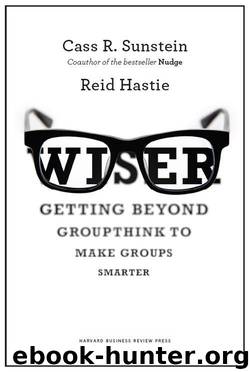Wiser: Getting Beyond Groupthink to Make Groups Smarter by Sunstein Cass R. & Hastie Reid

Author:Sunstein, Cass R. & Hastie, Reid [Sunstein, Cass R.]
Language: eng
Format: epub
ISBN: 9781625270504
Publisher: Harvard Business Review Press
Published: 2014-12-02T06:00:00+00:00
CHAPTER 7
A Framework for Improvement
Identifying and Selecting Solutions
On some occasions, a decision-making or problem-solving process demands critical thinking—winnowing out the chaff and zeroing in on the nuggets of good solutions. But on other occasions, it requires a more creative, less critical, more open-ended approach. Over the years that we have been involved in collective endeavors and immersed in the relevant behavioral findings, we have concluded that breaking down the process into two stages provides valuable insights on how to enhance group work. We have briefly referred to this point earlier; it is now time to offer more details about how to separate, implement, and optimize the divergent and convergent stages of every problem-solving process.
In some cases, the group begins with a set of possible solutions, and the remaining task is to select the best solution from that set. But often, groups have to solve a more complex problem. In such cases, the identification of potential solutions is the most important challenge that the group faces; the group must find and catalog those solutions before it can select the best one. In practice, it is often best to separate those two stages, identification and selection, of the larger process. Furthermore, the conditions that enhance each of the two stages are different. Effective process design depends on knowing when to execute each stage and how to provide for the different conditions that optimize each.
Much of what we have said bears on innovation and search, and not only on selection of the best solution. For example, the use of both red teams and role assignments can flush out solutions that a group initially neglected, as well as help in the evaluation and selection of decisions that have been identified. In this chapter, we make a sharp distinction between the identification and the selection of solutions, and we explore how groups should deal differently with the two tasks.
Download
This site does not store any files on its server. We only index and link to content provided by other sites. Please contact the content providers to delete copyright contents if any and email us, we'll remove relevant links or contents immediately.
| Bookkeeping | Business Mathematics |
| Business Writing | Communications |
| Decision Making | Negotiating |
| Project Management | Running Meetings & Presentations |
| Secretarial Aids & Training | Time Management |
| Training |
Nudge - Improving Decisions about Health, Wealth, and Happiness by Thaler Sunstein(7615)
Deep Work by Cal Newport(6879)
Principles: Life and Work by Ray Dalio(6208)
Factfulness: Ten Reasons We're Wrong About the World – and Why Things Are Better Than You Think by Hans Rosling(4694)
The Doodle Revolution by Sunni Brown(4685)
Eat That Frog! by Brian Tracy(4434)
Thinking in Bets by Annie Duke(4152)
Hyperfocus by Chris Bailey(4046)
Visual Intelligence by Amy E. Herman(3721)
Writing Your Dissertation in Fifteen Minutes a Day by Joan Bolker(3670)
Ogilvy on Advertising by David Ogilvy(3506)
How to Win Friends and Influence People in the Digital Age by Dale Carnegie & Associates(3495)
Hidden Persuasion: 33 psychological influence techniques in advertising by Marc Andrews & Matthijs van Leeuwen & Rick van Baaren(3472)
How to win friends and influence people by Dale Carnegie(3397)
The Pixar Touch by David A. Price(3362)
Schaum's Quick Guide to Writing Great Short Stories by Margaret Lucke(3319)
Deep Work: Rules for Focused Success in a Distracted World by Cal Newport(3146)
Work Clean by Dan Charnas(3048)
The Slow Fix: Solve Problems, Work Smarter, and Live Better In a World Addicted to Speed by Carl Honore(2947)
